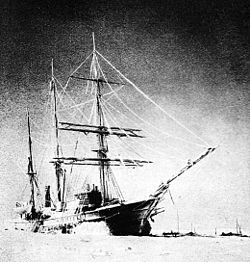Zarya (polar ship)

Zarya in 1902 during her second wintering
|
|
| History | |
|---|---|
|
|
|
| Name: | Harald Harfager |
|
|
|
| Name: | Zarya |
| Owner: | Russian Academy of Sciences |
| Acquired: | 1899 |
| General characteristics | |
| Class and type: | Brig |
| Tons burthen: | 450 tons |
| Draught: | 5 m |
| Propulsion: | Steam engine |
| Complement: | Crew of 20 |
Zarya (Russian: Заря, Sunrise) was a steam- and sail-powered brig used by the Russian Academy of Sciences for a polar exploration during 1900–1903.
Toward the end of the 19th century, the Russian Academy of Sciences sought to build a general-purpose research vessel for long-term expeditions. The first such Russian ship—and, for a couple of decades, the only one—was the Zarya. In 1899, Baron Eduard Toll, an Arctic explorer preparing to embark on a new polar voyage, bought a Norwegian three-masted barque called Harald Harfager (the nickname of a King of Norway) for the cost of 60,000 rubles. Toll was helped in his choice by Fridtjof Nansen, who recommended to use a ship similar to his Fram. The ship had a displacement of 450 tonnes and a draught of 5 meters.
Renamed Zarya, the ship was sent to the shipyard of Colin Archer in Larvik to be heavily modified in order to deal with the ice. In October 1899 the ship was certified by Norwegian authorities for a three-year expedition in the Arctic.
On June 21, 1900, Zarya left Saint Petersburg with a crew of 20. N. N. Kolomeitsev was the commander of the ship. On July 24 she arrived at the harbour of Alexandrovsk on Murman (today Polyarny) and then continued toward the Kara Sea. The Zarya made her first wintering trapped in the ice of a bay that Toll named after Colin Archer shipyard (Bukhta Kolin Archera) near Taymyr Island. The scientists spent 11 months researching the Nordenskiöld Archipelago and the Taymyr Peninsula coast. In the spring Kolomeitsev was sent on a long sledge trip by expedition leader Eduard Toll, and at this point second-in-command, Fyodor Andreyevich Matisen became the captain for the remaining part of the expedition. Member of the expedition was Aleksandr Kolchak.
...
Wikipedia
